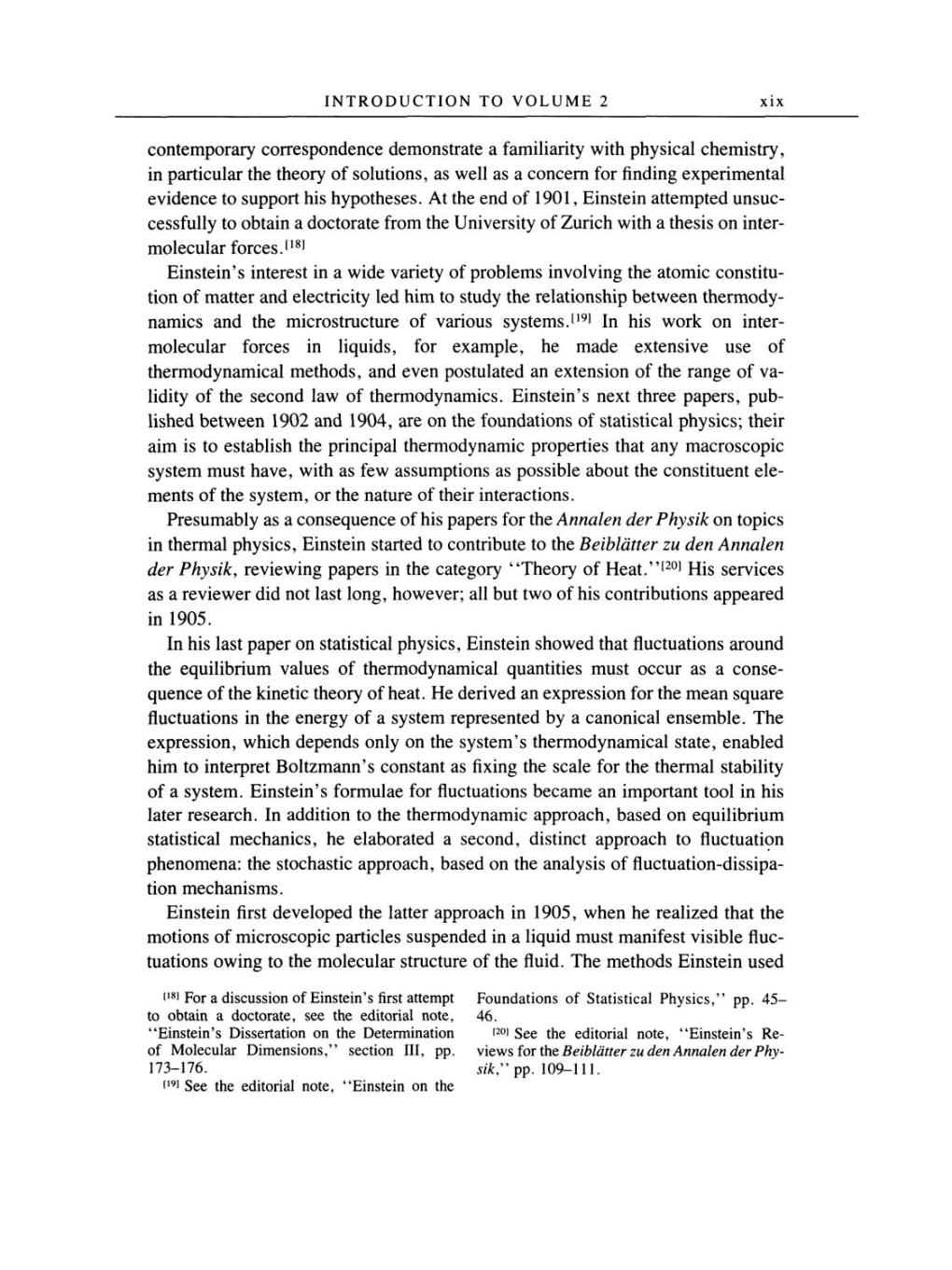INTRODUCTION
TO VOLUME
2
xix
contemporary correspondence
demonstrate
a
familiarity
with
physical
chemistry,
in
particular
the
theory
of
solutions,
as
well
as
a concern
for
finding
experimental
evidence
to
support
his
hypotheses.
At the end
of
1901,
Einstein
attempted unsuc-
cessfully
to
obtain
a
doctorate from
the
University
of
Zurich
with
a
thesis
on
inter-
molecular
forces.[18]
Einstein's
interest
in
a
wide
variety
of
problems involving
the atomic
constitu-
tion
of
matter and
electricity
led him
to
study
the
relationship
between
thermody-
namics and the microstructure
of
various
systems.[19]
In his work
on
inter-
molecular forces in
liquids,
for
example,
he
made extensive
use
of
thermodynamical
methods,
and
even postulated an
extension
of
the
range
of
va-
lidity
of
the second law
of
thermodynamics.
Einstein's
next
three
papers,
pub-
lished between 1902 and
1904,
are on
the foundations of statistical
physics;
their
aim is to establish the
principal thermodynamic properties
that
any macroscopic
system
must have,
with
as
few
assumptions
as
possible
about the constituent ele-
ments
of
the
system,
or
the
nature
of
their interactions.
Presumably as a consequence
of
his
papers
for
the
Annalen
der
Physik
on
topics
in thermal
physics,
Einstein started
to
contribute to the
Beiblätter
zu
den Annalen
der
Physik, reviewing papers
in the
category
"Theory
of
Heat."[20] His services
as a
reviewer
did not last
long,
however;
all but
two
of
his contributions
appeared
in
1905.
In his last
paper on
statistical
physics,
Einstein showed that fluctuations around
the
equilibrium
values
of
thermodynamical quantities
must
occur
as
a conse-
quence
of
the
kinetic
theory
of
heat. He derived
an expression
for the
mean
square
fluctuations
in
the
energy
of
a
system represented by
a
canonical ensemble. The
expression,
which
depends only
on
the
system's
thermodynamical
state,
enabled
him to
interpret
Boltzmann's
constant
as
fixing
the scale for the thermal
stability
of
a
system.
Einstein's
formulae
for
fluctuations became
an
important
tool in his
later research. In addition
to
the
thermodynamic approach,
based
on
equilibrium
statistical
mechanics,
he elaborated
a
second,
distinct
approach
to
fluctuation
phenomena:
the stochastic
approach,
based
on
the
analysis
of
fluctuation-dissipa-
tion mechanisms.
Einstein first
developed
the
latter
approach
in
1905,
when he realized
that
the
motions
of
microscopic particles suspended
in
a
liquid
must
manifest visible fluc-
tuations
owing
to
the molecular structure of the fluid. The methods Einstein used
[18]
For
a
discussion
of Einstein's
first
attempt
to obtain
a
doctorate,
see
the editorial note,
"Einstein's
Dissertation
on
the Determination
of
Molecular Dimensions," section
III,
pp.
173-176.
[19]
See the editorial
note,
"Einstein
on
the
Foundations of Statistical
Physics,"
pp.
45-
46.
[20]
See the editorial
note,
"Einstein's
Re-
views
for
the
Beiblätter
zu
den Annalen
der
Phy-
sik,"
pp.
109-111.
